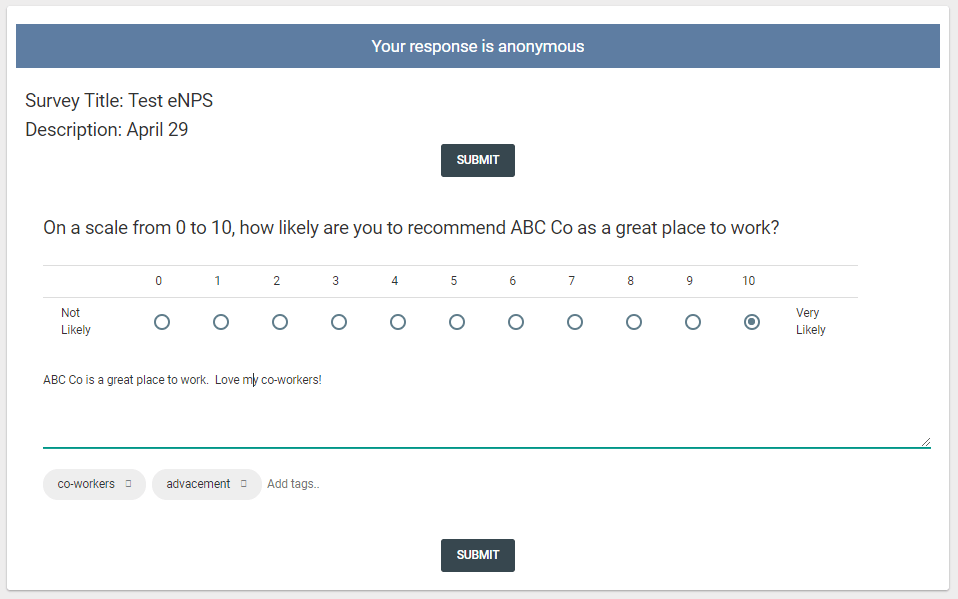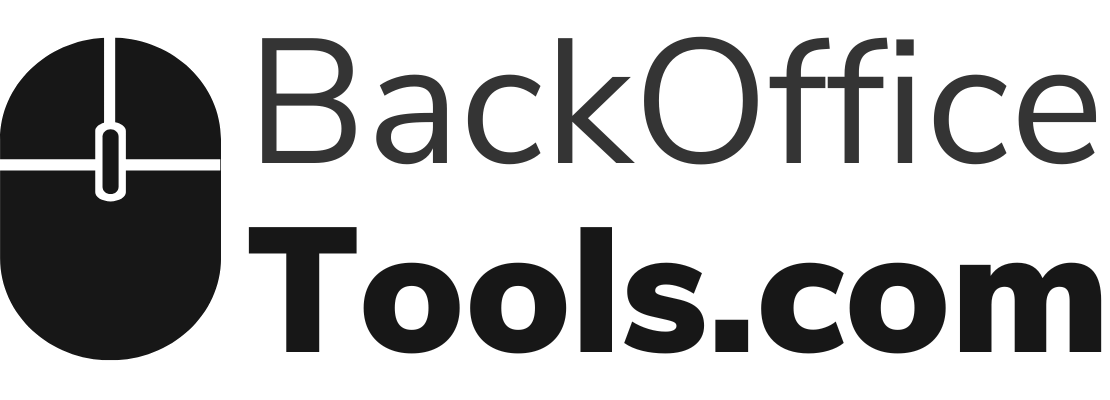Back Office Tools and eNPS(®)
The Net Promoter Score, or NPS, is a customer satisfaction benchmark that rates the likely hood of your customer recommending your product or service to someone else. Your customer rates you on an NPS scale that begins at 0 (unlikely) and ends at 10 (likely). The scores are then transformed into a -100 to +100 NPS score.
eNPS Survey
An eNPS survey is typically a simple, one question survey that may be emailed to your employee or delivered through an in-browser or in-product pop-up form. At Back Office Tools, we deliver the eNPS survey via an emailed link.
Once you click on the link, you will see the eNPS survey below. It includes a text box asking for a free form response from your employee. Your employee may also add hashtags to reinforce important topics.

The text response provides invaluable feedback on the satisfaction or frustration of employees. Initially, NPS was company-focused, but now you see the NPS rating in a wide variety of settings including internally focused surveys.
eNPS surveys at Back Office Tools are anonymous. And once the employee has submitted his or her response, the link is no longer active.
eNPS Rating
An eNPS survey asks the recipient to rate your company on a scale from 0 to 10. The 0 to 10 rating is bucketed into three categories of respondents. These include promoters, passives, and detractors.
Promoters – a rating of 9 or 10 classifies the survey taker as a promoter. These are enthusiasts of your company and very likely to recommend your company to someone else.
Passives – a rating of 7 or 8 classifies the survey taker as a passive. They may like your company but are indifferent. They are riding the fence and have the potential to slip or up down the scale.
Detractors – a rating from 0 to 6 classifies the survey taker as a detractor. They are unhappy employees who would not recommend your company.

How to Calculate an eNPS Score?
The calculation of the NPS score is straight forward. The steps are outlined below.
- First, calculate the percentage of respondents who rated you as a promoter (9 or 10).
- Second, calculate the percentage of respondents who rated you as a 0 to 6.
- The net promoter score is calculated by subtracting the % detractors from % promoters.
That’s it! An example eNPS calculation below.

But don’t worry! We calculate the NPS score for you. Our NPS dashboard displays your current NPS score and the percentages by response type. You can also view your scores by survey or in aggregate.


What is Employee NPS?
The NPS score is now being focused on internal company topics such as employee happiness or sentiment. This is called the employee net promoter score or eNPS.
No longer is NPS focused solely on your product, features, or strategy. Imagine applying the NPS system to your staff.

After all, employees are a company’s biggest asset. Competitive advantage is driven not by the product but the people who are creating the product and driving the company forward.
Strong employee promoters can drive improved company performance through better engagement, better customer experiences, and their overall positive energy inside your teams.
It only makes sense that company leaders would like to understand the internal vibe of the office and improve upon it. A great human resources department can often pick up on the office vibe, but this can be somewhat subjective and hard to translate to your executive team or Board in a PowerPoint slide.
Benefits of an Employee Net Promoter Score
Translating employee sentiment into an eNPS score, although not perfect, can provide great insight into culture, retention, and motivation. Rather than relying on subjective measures, the eNPS survey attempts to quantify the office vibe or sentiment.
In addition to receiving a rating, employees have the chance to provide anonymous text feedback. Again, the insight from this feedback is invaluable.
How often have you been in a Board meeting or executive meeting and been asked about employee morale? It’s such an important topic but hard to translate “watercooler talk” to your Board without some method of quantification.
Gone are the days of huge annual employee surveys and even the annual performance review. Short, quick, actionable feedback is dominant now. You can course correct throughout the year rather than just once a year.
Action Item
With today’s technology there is no excuse for not asking for employee feedback. You may think that you have the best culture and employee morale but you don’t know until you ask for honest feedback.
Note: NPS, Net Promoter & Net Promoter Score are registered trademarks of Satmetrix Systems, Inc., Bain & Company and Fred Reichheld.

